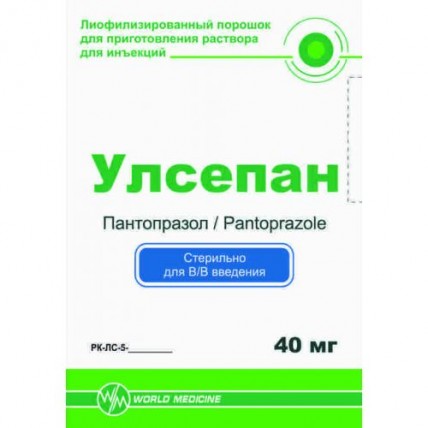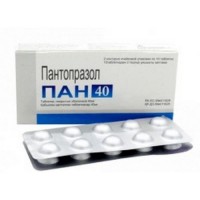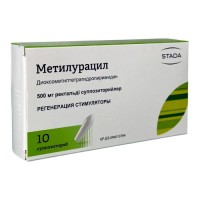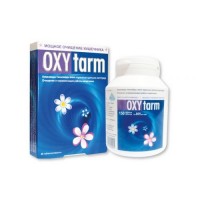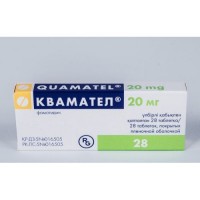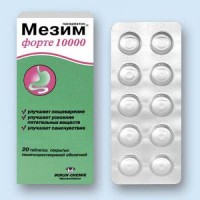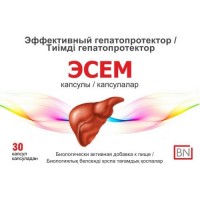Ulsepan 1's 40 mg lyophilized powder for injection
- $17.20
The instruction for medical use of Ulsepan Torgovoye medicine a name Ulsepan Mezhdunarodnoye the unlicensed name Pantoprazol Lekarstvennaya a form the Lyophilized powder for preparation of solution for injections of 40 mg Structure One bottle contains active agent – a pantoprazol of sodium of sexivihydrat of 45.11 mg (it is equivalent a pantoprazola to the basis of 40 mg), excipient – 0.1 M hydroxide sodium solution the Description the Lyophilized powder of white or almost white color Pharmacotherapeutic group Drugs for treatment of the diseases connected with disturbance of acidity. Antiulcerous drugs and drugs for treatment of a gastroezofagalny reflux (GORD). Inhibitors of the protonew pump. Pantoprazol. The ATX A02BC02 code does not kumulirut the Pharmacological Pantoprazol Pharmacokinetics properties and its pharmacokinetics is identical both after single, and after repeated use of drug. After intravenous administration increase in the range of doses from 10 to 80 mg of Cmax and AUC in proportion to the entered doses. After introduction of 40 mg of a pantoprazol intravenously with a constant speed not less than 15 minutes of Cmax makes 5.52 mkg/ml, AUC – 5.4 мкг×ч/мл. Linking of a pantoprazol with proteins of blood plasma makes 98%, the volume of distribution fluctuates ranging from 11.0 up to 23.6 l, clearance - 0.1 l/h/kg. Pantoprazol is metabolized in a liver with the participation of the system of R-450 cytochrome, the main metabolite is desmetilpantoprazol, conjugating with sulfate. In the form of metabolites, kidneys excrete about 71%, by way of biliary excretion - 18% of the entered dose. T1/2 of a pantoprazol-1 hour, metabolite T1/2 - about 1.5 hours. The pharmacokinetics in special cases Pharmacokinetics of a pantoprazol was not studied at persons 18 years are younger. Small increase in an indicator of AUC and Cmax at elderly people is not clinically significant and does not demand correction of a dose. At use of a pantoprazol for patients with a renal failure (including) the dose decline is not required from the patients who are on a hemodialysis. At patients with a liver failure at use of solution for intravenous administration the T1/2 value increases to 7-9 h, the indicator of AUC increases by 5-7 times, Cmax increases by 1.5 times. Doses over 40 mg a day at such patients were not studied. A pharmacodynamics Inhibitor of the protonew pump (N + - To +-ATF-azy). Blocks a final stage of secretion of hydrochloric acid, reducing basal and stimulated secretion, irrespective of the irritant nature. At intravenous administration the anti-secretory effect of a pantoprazol reaches a maximum within 1 hour and 24 hours remain. Does not affect motility of a GIT. The secretory activity is normalized in 3-4 days after the end of use. Indications - a reflux esophagitis - Zollingera-Ellison's syndrome and other morbid hyper secretory conditions the Route of administration and doses it is necessary to Enter Ulsepan intravenously only when reception of a pantoprazol inside is impossible. A reflux esophagitis the Recommended dose of 40 mg once a day. The treatment period an intravenous form is short, the patient should be transferred to oral administration of drug as soon as possible. Administration of drug within 7 days can be required. Preparation of solution for intravenous drop administration To a bottle with the lyophilized powder is added by 10 ml of normal saline solution of sodium of chloride (primary solution). Primary solution of a pantoprazol is mixed from 100 ml of normal saline solution of sodium of chloride or 5% of solution of glucose to final concentration of 0.4 mg/ml. Solution is used directly after preparation. Ready solution is entered intravenously by drop infusion within 15 minutes with a speed about 7 ml/min. Preparation of solution for injections To a bottle with the lyophilized powder is added by 10 ml of normal saline solution of sodium of chloride to final concentration of 4.0 mg/ml. Solution is used directly after preparation. Ready solution is entered intravenously within 2 minutes. Zollingera-Ellison's syndrome and other morbid hyper secretory conditions. The recommended dose in an initiation of treatment of 80 mg two times a day. The dose can vary depending on specific features of the patient. Preparation of solution for intravenous drop administration To two bottles with the lyophilized powder is added on 10 ml of normal saline solution of sodium of chloride (primary solution). Combine primary solution from two bottles and mix from 80 ml of normal saline solution of sodium of chloride or 5% of solution of glucose to final concentration 0.8 mg/ml. Solution is used directly after preparation. Ready solution is entered intravenously by drop infusion within 15 minutes with a speed about 7 ml/min. Preparation of solution for injections with the lyophilized powder add To two bottles on 10 ml of normal saline solution of sodium of chloride to final concentration 4.0 mg/ml. Solution is used directly after preparation. Combine solution from two bottles and enter intravenously within 2 minutes. In case of use of drug in a daily dose over 80 mg, a dose can be divided and be entered twice a day. Perhaps temporary increase in a daily dose up to 160 mg. The course of treatment depends on clinical need. Special groups of patients At patients with the profound abnormal liver functions the daily dose of drug should not exceed 20 mg. Side effects are listed below the observed side reactions with a frequency of their occurrence: very often (≥1/10), it is frequent (from ≥ 1/00 to & lt, 1/10), infrequently (from ≥ 1/1000 to & lt, 1/100), is rare (from ≥ 1/10000 to & lt, 1/1000), is very rare (& lt, 1/10000), it is unknown (it is impossible to estimate on the available data). Often - thrombophlebitis in the place of an injection Infrequently - a headache, dizziness - dryness in a mouth, nausea, vomiting, an abdominal distension, abdominal pain and discomfort, diarrhea, a constipation - skin rash, an itching, a dieback - an asthenia, an utoslyaemost and an indisposition - increase in activity of liver enzymes (transaminases, γ – GT) - the sleep disorder Is rare - an agranulocytosis - hypersensitivity to active and to auxiliary components of drug (including anaphylactic reactions and an acute anaphylaxis) - a lipidemia, increase in level of triglycerides, cholesterol - increase in content of bilirubin - change of weight, disturbance of taste - a depression (and all accompanying deteriorations) - disturbance sight/illegibility of sight - urticaria, a Quincke's disease - an arthralgia, myalgia - a gynecomastia - fervescence, peripheral hypostases Very seldom - thrombocytopenia, a leukopenia, a pancytopenia - a disorientation (and all accompanying deteriorations) It is unknown - a hyponatremia, a hypomagnesiemia - hallucinations, confusion of consciousness (especially at the patients predisposed to these states and also deterioration in these symptoms if they existed prior to treatment) - hepatocellular damages, jaundice, hepatocellular insufficiency - Stephens's syndrome – Johnson, a Lyell's disease, an exudative mnogoformny erythema, photosensitivity - interstitial nephrite of the Contraindication - hypersensitivity to a pantoprazol and auxiliary components of drug - hepatitis and cirrhosis accompanying with a heavy liver failure - combined use with atazanaviry - the profound renal failures Medicinal interactions At simultaneous use of drugs which bioavailability depends from rn stomach environments (for example, ketokonazol), Ulsepan can change their absorption. Because pantoprazol it is metabolized in a liver by the fermental system of P450 cytochrome, it is impossible to exclude a possibility of medicinal interaction with the drugs which are metabolized the same fermental system. Special instructions Prior to therapy it is necessary to exclude a possibility of a malignant new growth of a stomach and gullet as Ulsepan's use can reduce expressiveness of symptoms and delay establishment of the correct diagnosis. The diagnosis a reflux esophagitis demands obligatory endoscopic confirmation. At use for patients with abnormal liver functions it is regularly necessary to control activity of liver enzymes in blood plasma and, at their increase to cancel Ulsepan. Lowering of acidity of a stomach increases quantity of gastric bacteria which usually are present in zheludochno – an intestinal path. Treatment by the drugs lowering acidity leads to increase in risk of developing the gastrointestinal infections caused by such microorganisms as Salmonella, Campylobacter. Use in pediatrics Because of insufficient amount of data on safety and efficiency is not recommended use of drug at treatment of children and teenagers up to 18 years. Pregnancy and a lactation Use of drug during pregnancy is possible if the expected advantage for mother exceeds potential risk for a fruit or the child. The lactation during drug treatment should be stopped. Features of influence of medicine on ability to run the vehicle or potentially dangerous mechanisms Considering side effects of drug, it is necessary to be careful at control of vehicles and work with potentially dangerous mechanisms. Overdose Symptoms: strengthening of side effects. Treatment: Pantoprazol is not brought by means of a hemodialysis. Performing the supporting and symptomatic therapy is recommended. The form of release and packing On 40 mg of drug place in bottles of colourless glass. On 1 bottle place in blister strip packaging. On 1 planimetric packing together with the instruction for medical use in the state and Russian languages place in a cardboard box. To Store storage conditions in the place protected from light at a temperature not above 25 °C. To store out of children's reach! Not to freeze. 3 years not to apply a period of storage after an expiration date. To use the prepared solution within 12 hours. Prescription status According to the prescription the Producer "Mefar Ilach Sang. A.Sh.", Ramazanoglu Move., Ensar Dzhad. No.: 20, 34906 Pendik-Kurtkyoy / Istanbul, Turkey the Owner of the registration certificate "UORLD MEDITSIN", GREAT BRITAIN the Address of the organization accepting in the territory of the Republic of Kazakhstan claims from consumers on quality of products of RK, Rihn-pharmaceutical LLP, Almaty, Turksibsky district, Suyunbaya Ave., 222b Ph. / fax: 8 (7272) 529090 Address of the organization responsible for post-registration observation of safety of medicine of TROKA-S PHARMA LLP, Almaty, Suyunbaya Avenue 222-b Cellular ph. +7 701 786 33 98, (24-hour access).
To develop
To develop
